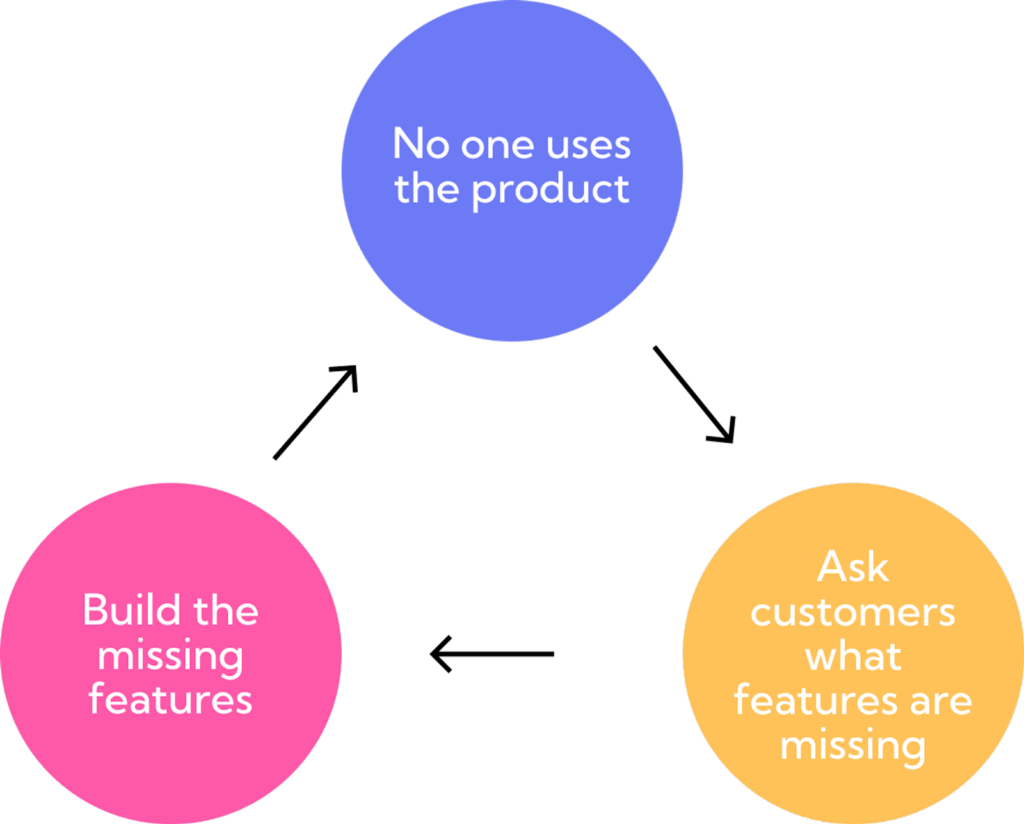The term “Product Management” may have reached your ears, stirring up extensive entrepreneurial discussions in recent years. It has now emerged as a pivotal factor in various company discovery and delivery processes, leaving a significant impact on Agile management practices.
With more than 10 years of experience helping over 100+ startups, scaleups and ambitious SME’s with their product or service, we’ve dealt with many mistakes regarding managing the teams and aligning stakeholders to provide a meaningful solution to users.
This is why we wrote this piece to help you deal with the most common pitfalls of shaping a product. We also wanted to give you some essential knowledge you’re going to need to to leverage a better product thinking for a winning solution.
You’ll learn:
For our most curious readers, we’ve curated two comprehensive pieces of content to dive deeper into each subject!
1. A brief definition of Product Management
Product management is the art of guiding a product’s lifecycle, from development to pricing, by focusing on putting customers first.
This discipline crosses technology, business, and user experience.
Product departments advocate for customers within the organization.
- They ensure that the company understands the voice of the market, all in the pursuit of building the best possible product.
- Providing value to end users while meeting business goals is the aim of their job.
All that, following an Agile way of thinking.
Want to discuss your product management? We’d love to help!
2. Product vs. Project Management : any difference?
Since the two terms seem very familiar, let’s separately define them.
Let’s clear this up once and for all:
- Product managers are responsible for the product vision, aligning all teams thanks to a roadmap (time-framed action plan with goals)
- Project managers are responsible for getting the logistics, scheduling, planning, and task allocations done
Here’s a little table listing the main differences between the two positions.

Now that everything’s clearer, let’s point out the common pitfalls of shaping and managing a product.
The Common Pitfalls of Product Management
Some product teams or entrepreneurs tend to fall into rabbit holes when crafting their solution.
Here are the most common ones:
1. Falling in love with your solution
One common danger when trying to solve a problem is becoming too attached to the solution you found. We know it’s really easy for entrepreneurs or development/product teams to fall into this trap.
Although it’s important to find the right solution to a problem, it is essential to recognize that there can be hundreds.
Here are a few resources that can provide further insights on this topic:
- Article: Fall in love with the problem, not the solution : This article by Richard Bagdonas explores the risks associated with becoming too attached to your solution.
- Book: “The Lean Startup” by Eric Ries – A staple of business readings, emphasizing the importance of testing assumptions and quick iterations to find the best solution for a given problem.
2. Misunderstanding user feedback
While user feedback is essential, it’s important to go beyond surface-level, and dig deeper into user stories.
Exploring stories more means putting yourself in your customer’s shoes. More on that later.
This ensures that the features you prioritize provide enough value to your users. Frameworks like Jobs-To-Be-Done can effectively target the underlying need (the job) your users want when interviewing them or analyzing feedback.
- Article: How to Collect and Analyze User Feedback Effectively – This article provides practical tips for analyzing and acting on user feedback to drive product improvements.
- Book: “Validating Product Ideas” by Tomer Sharon – This book offers guidance on effectively validating product ideas through user research and feedback, helping you make informed decisions based on user insights.

3. Excessive Planning
Overly detailed planning can hinder progress, stifle innovation, and impede timely execution.
Although planning is important, it’s also important to emphasize essential planning elements.
- Article: A Guide to Time Management for Product Managers – An overview of agile planning principles. Offers practical steps to install efficient time-planning strategies. Not only for product, but also for all the organization.
- Book: “Scrum: The Art of Doing Twice the Work in Half the Time” by Jeff Sutherland -This book delves into the Scrum framework, emphasizing the importance of iterative planning and delivering value in shorter cycles.
4. Poor Prioritization
Poor prioritization can lead to missed opportunities and suboptimal resource allocation. Since it is the core of delivering a good product, managers should
User value, business impact, technical feasibility, and other relevant parameters influence prioritization efficiency.
Techniques like impact/effort matrix would help product people make more informed decisions
- Article: A Framework for Prioritizing Features – This article offers a comprehensive framework for prioritizing features based on user value, business impact, and effort.
- Book: “Product Roadmaps Relaunched: How to Set Direction While Embracing Uncertainty” by C. Todd Lombardo, Bruce McCarthy, Evan Ryan, and Michael Connors – Invaluable insights for creating effective product roadmaps that align with priorities, stakeholder needs, and market dynamics.
5 Best Practices to shape a great product
If you’ve read this far, you may understand that shaping a great product is not an easy task. It takes a lot of effort and vision.
Here are our 5 recommendations to avoid the common pitfalls of Product Management :
1. Fall In Love with your Problem
Just like in life, your crush is not always the One!
Shift your focus from falling in love with your solution to falling in love with the problem you are trying to solve.
This shift allows you to better understand the needs and pain points of your target users.
Here are some key recommendations to embrace this approach:
- Article: Decision Framework ; Falling in love with the problem – This series of article by The Lean Startup Co. is your go-to if you want to really understand how to solve a problem.
- Book: “Sprint: How to Solve Big Problems and Test New Ideas in Just Five Days” by Jake Knapp, John Zeratsky, and Braden Kowitz – The Google Design Sprint Framework, focusing on fast, quickly validated solutions.
2. Be Your own customer
To ensure that your product meets the needs of your target audience, put yourself in their shoes.
An experience exceeding expectation is an instant win. Empathize on your customers’ pains, gains, and expectations.
Involving yourself in using the product and seeking user feedback
- Article: How To Be a Good Product Manager : Understand Your Customer – This article emphasizes the importance of understanding customers for effective product management. It suggests using existing data, interviewing stakeholders, benchmarking competition, and conducting field research to gain insights.
- Book: “The Mom Test: How to Talk to Customers and Learn if Your Business is a Good Idea When Everyone is Lying to You” by Rob Fitzpatrick – The most practical advice of all. Have an idea? Ask your mom.
3. Ship first
Instead of striving for perfection from the outset, focus on shipping a Minimum Viable Product (MVP) with essential, high-value features to early adopters.
This approach accelerates time-to-market, validates product-market fit, and gathers invaluable user feedback. By iterating quickly and improving your product based on user feedback, you can strive for perfection over time.
- Article: If Your Startup Wants a Great Product, Launch It Before it’s Ready – The article on Built In advocates for launching a product even if it’s not fully ready, emphasizing the value of a Minimum Viable Product (MVP). It argues that MVPs provide crucial market feedback, guiding what to build, how to sell it, and at what price.
- Book: “The Lean Startup” by Eric Ries – This book dives into the principles of lean startup methodology, including the concept of shipping minimum viable products and iterating based on customer feedback.
4. Validate your Solution
Ensure that your solution addresses a genuine need in the market. Seek validation from stakeholders, interview users, conduct beta tests. It’s all about Validating before Scaling.
- Article: 5 Steps for Validating Your Product Idea – This article outlines five steps for effectively validating your product idea and ensuring its market viability.
- Book: “Testing Business Ideas: A Field Guide for Rapid Experimentation” by David J. Bland and Alexander Osterwalder – This book provides a comprehensive guide to conducting experiments and validating business ideas through testing and experimentation.
5. Implement Robust Data Analytics
Qualitative user feedback is valuable, but numbers provide an objective perspective. Implementing robust data collection mechanisms is the best way to gain a deep understanding of your users’ behavior.
Leverage analytics tools to measure performance, engagement, and user experience. This data-driven approach enables you to make informed decisions based on concrete insights, rather than assumptions.
- Article: Data-Driven Product Management – This comprehensive guide provides insights into implementing data-driven practices in product management and leveraging data analytics to drive decision-making.
- Book: “Lean Analytics: Use Data to Build a Better Startup Faster” by Alistair Croll and Benjamin Yoskovitz – This book offers valuable insights into using data and analytics to drive decision-making and accelerate the growth of startups. It covers various topics like conducting effective A/B testing, analyzing user behavior, and leveraging data-driven strategies for product development.
Conclusion
By following these recommendations, you will mitigate some of these pitfalls.
It all comes down to:
- Remembering to stay focused on the problem.
- Listening to users
- Prioritizing rapid delivery
- Leveraging data for informed decision-making.
By combining these best practices with your extensive expertise in product management, you will be well-equipped to create and launch successful digital products.
In fine, it’s essential to keep in mind that failure is part of the game.
Let’s finish with a quote from expert Product Leader Ken Norton said in an interview.
“Product is like playing a game. You start by the tutorial, get the basics of the game down, make your way through the levels, and eventually finish the game. but it doesn’t stop there. If you want to become even better, you need to gather the skills to design the game yourself, making your own rules.
Need help managing your digital product? Book a free consultation!



